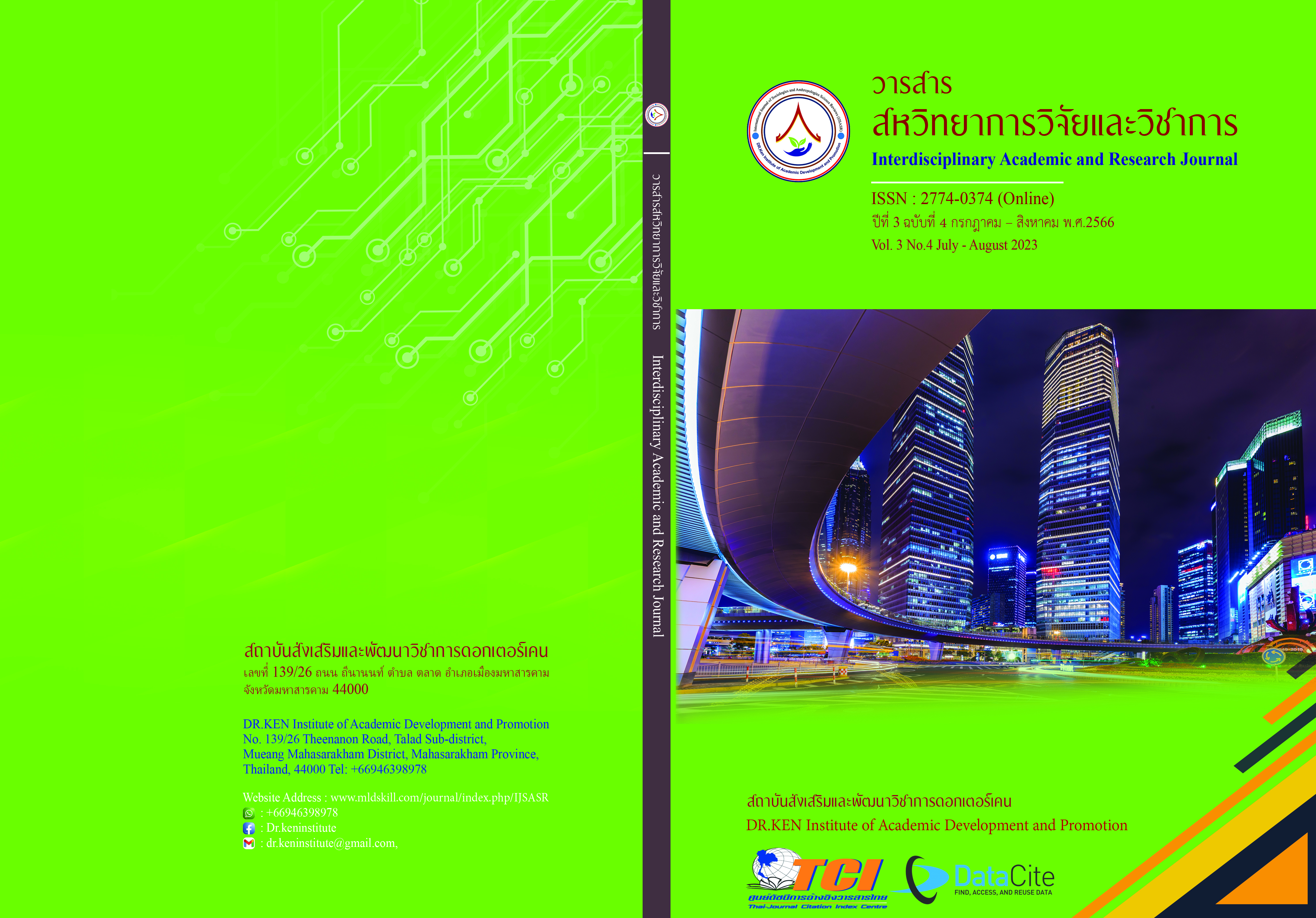The Development of Mathematical Learning Achievement on Multiplication Using Skill Exercises for Prathomsuksa 2 Students at Suraohayeemina School
DOI:
https://doi.org/10.14456/iarj.2023.215Keywords:
Mathematics Learning Achievement; , Multiplication; , Skill ExercisesAbstract
Mathematics education aims to study problem-solving methods to improve student performance. Skills exercises and tests are tools that can effectively train students to develop thinking skills and enable self-learning based on individual abilities. These tools also allow teachers to assess and evaluate learners efficiently, resulting in comprehensive learning outcomes. The use of skills exercises and tests provides an additional option to ensure comprehensive measurement of learning outcomes in the content. Therefore, this research aims to create efficient multiplication skills exercise for Prathomsuksa 2 students at the standard criteria of 80/80 and compare mathematics learning achievement on multiplication of PrathomSuksa 2 students before and after using the exercise. The study sample consists of 35 PrathomSuksa 2 students from Suraohayeemina School in the 2022 academic year, selected through purposive sampling. The research tools used include 1) a skills exercise on multiplication for PrathomSuksa 2 students and 2) a mathematics learning outcome assessment test on multiplication for PrathomSuksa 2 students, with difficulty values ranging from 0.24 - 0.72, discrimination indices ranging from 0.20 - 0.75, and a reliability coefficient of 0.82. Statistical analysis used in data interpretation includes percentages, means, standard deviations, and t-tests. The results of the study were as follows. 1) The effectiveness of the mathematics skills exercise on multiplication for PrathomSuksa 2 students yielded a score of 83.63/85.16, which surpasses the predetermined criterion. 2) This suggests that the exercise was highly effective in improving students' multiplication skills. The learning outcomes in mathematics, specifically in multiplication, showed a significant increase after using the skills exercise. The post-learning scores were statistically higher than the pre-learning scores at a significance level of.05.
References
กระทรวงศึกษาธิการ. (2560). ตัวชี้วัดและสาระการเรียนรู้แกนกลาง กลุ่มสาระการเรียนรู้คณิตศาสตร์ (ฉบับ ปรับปรุง พ.ศ.2560) ตามหลักสูตรแกนกลางการศึกษาขั้นพื้นฐาน พุทธศักราช 2551. กรุงเทพฯ: กระทรวงศึกษาธิการ.
ชัยยงค์ พรหมวงศ์. (2556). การทดสอบประสิทธิภาพสื่อหรือชุดการสอน. วารสารศิลปากรศึกษาศาสตร์. 5 (3), 7 – 20.
ถวัลย์ มาศจรัส. (2551). การพัฒนาคุณภาพผลงานทางวิชาการด้วยนวัตกรรม 3 มิติ. กรุงเทพฯ: 21 เซ็นจูรี.
ทิวาพร แก้วคำสอน. (2564). การพัฒนาแบบฝึกทักษะคณิตศาสตร์ เรื่อง ความน่าจะเป็น โดยใช้การเรียนรู้แบบ ร่วมมือเทคนิค TAI ร่วมกับเทคนิค KWDL สำหรับนักเรียนชั้นมัธยมศึกษาปีที่ 3. วารสารบัณฑิตศึกษา. 80 (18), 96-104.
ทิศนา แขมมณี. (2554). ศาสตร์การสอน: องค์ความรู้เพื่อการจัดกระบวนการเรียนรู้ที่มีประสิทธิภาพ (พิมพ์ครั้ง ที่ 14). กรุงเทพฯ: จุฬาลงกรณ์มหาวิทยาลัย.
นราทิพย์ ใจเพียร. (2562). การพัฒนาผลสัมฤทธิ์ทางการเรียนคณิตศาสตร์เรื่อง การบวก ลบ ทศนิยม สำหรับ นักเรียนชั้นประถมศึกษาปีที่ 4 โดยใช้แบบฝึกทักษะ. วารสารวิชาการ. 13 (3), 49-57.
นูรีมาน สือรี. (2563) การพัฒนาผลสัมฤทธิ์ทางการเรียน เรื่อง เลขยกกำลัง โดยใช้แบบฝึกทักษะสำหรับนักเรียนระดับชั้นมัธยมศึกษาปีที่ 1. วิทยานิพนธ์ปริญญาการศึกษามหาบัณฑิต มหาวิทยาลัยทักษิณ.
ประสาท เนืองเฉลิม. (2556). วิจัยการเรียนการสอน. กรุงเทพฯ: จุฬาลงกรณ์มหาวิทยาลัย.
รำไพ ดวงบุบผา. (2561). การพัฒนาแบบฝึกทักษะคณิตศาสตร์ประกอบการจัดกิจกรรมการเรียนรู้ตามรูปแบบ STAD เรื่อง การคูณ สำหรับนักเรียนชั้นประถมศึกษาปีที่ 3. วารสารบัณฑิตวิทยาลัย พิชญทรรศน์. 13 (1), 115-122.
โรงเรียนสุเหร่าหะยีมินา, กลุ่มงานวิชาการ. (2564). รายงานผลการประเมินตนเองของสถานศึกษา ปีการศึกษา 2564 ระดับการศึกษาขั้นพื้นฐาน. กรุงเทพฯ: โรงเรียนสุเหร่าหะยินา.
ศิริชัย กาญจนวาสี. (2556). ทฤษฎีการทดสอบแบบดั้งเดิม. พิมพ์ครั้งที่ 7. สำนักพิมพ์แห่งจุฬาลงกรณ์มหาวิทยาลัย.
ศิวริน เกณทวี. (2557). การพัฒนาการจัดกิจกรรมการเรียนรู้แบบฮิวริสติกส์ เรื่อง สมการเชิงเส้นตัวแปรเดียวของ นักเรียนชั้นมัธยมศึกษาปีที่ 1. วารสารบัณฑิตวิทยาลัยพิชญทรรศน์, 9 (1), 130.
สถาบันทดสอบทางการศึกษาแห่งชาติ. (2564). รายงานผลการทดสอบทางการศึกษา ระดับชาติขั้นพื้นฐาน (O-NET) ปีการศึกษา 2564. Retrieved on 14 August 2022, from: http://www.newonetresult.niets.or.th/AnnouncementWeb/Login.aspx
สถาบันส่งเสริมการสอนวิทยาศาสตร์และเทคโนโลยี. (2546). คู่มือการจัดการเรียนรู้ กลุ่มสาระการเรียนรู้ คณิตศาสตร์. กรุงเทพฯ: ผู้แต่ง.
สมนึก ภัททิยธนี. (2556). การวัดผลการศึกษา. พิมพ์ครั้งที่ 9. ประสานการพิมพ์.
สุคนธ์ สินธุพานนท์. (2553). นวัตกรรมการเรียนการสอนเพื่อพัฒนาคุณภาพของเยาวชน. พิมพ์ครั้งที่ 4. กรุงเทพฯ: 9119 เทคนิค พริ้นติ้ง.
อนงพันธ์ ใบสุขันธุ์. (2551). การใช้แบบฝึกเพื่อพัฒนาทักษะการคิดของนักเรียนชั้นอนุบาล. การค้นคว้าแบบ อิสระปริญญามหาบัณฑิต มหาวิทยาลัยเชียงใหม่.
อารยา ยุวนะเตมีย์. (2560). การเปรียบเทียบพัฒนาการทักษะการแก้ปัญหาทางคณิตศาสตร์และพัฒนาการการรับรู้ความสามารถของตนเองทางคณิตศาสตร์ของนักเรียนมัธยมศึกษาตอนต้นที่ใช้วิธีการประเมินตนเองต่างกัน: วิธีการรูบริกแอนโนเทตประยุกต์และแบบสอบถามปลายเปิด. วารสารอิเล็กทรอนิกส์ทางการศึกษา, 13 (1), 270-284
Downloads
Published
How to Cite
Issue
Section
License
Copyright (c) 2023 Savina Boonsen

This work is licensed under a Creative Commons Attribution-NonCommercial-NoDerivatives 4.0 International License.
Copyright on any article in the Interdisciplinary Academic and Research Journal is retained by the author(s) under the under the Creative Commons Attribution-NonCommercial-NoDerivatives 4.0 International License. Permission to use text, content, images, etc. of publication. Any user to read, download, copy, distribute, print, search, or link to the full texts of articles, crawl them for indexing, pass them as data to software, or use them for any other lawful purpose. But do not use it for commercial use or with the intent to benefit any business.
















.png)


